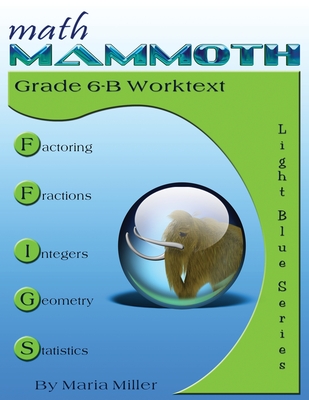Math Mammoth Grade 6-B Worktext

Math Mammoth Grade 6-B Worktext
Math Mammoth Grade 6-B Worktext is the second student book in Math Mammoth grade 6 curriculum, meant for the latter half of 6th grade. This is the 2022 edition.
The main areas of study in Math Mammoth Grade 6-B worktext are: prime factorization, GCF, and LCMfraction arithmetic with a focus on division of fractionsthe concept of integers, coordinate grid, addition & subtraction of integersgeometry: review of quadrilaterals & drawing problems; area of triangles & polygons; volume of rectangular prisms with fractional edge lengths; surface areastatistics: concept of distribution, measures of center, measures of variation, boxplots, stem-and-leaf plots, histograms
Chapter 6 first reviews prime factorization and then teaches students two new concepts: the greatest common factor and the least common multiple. We also apply those concepts factor to simplify fractions and to find common denominators for adding fractions.
In Chapter 7, students first review addition, subtraction, and multiplication of fractions from fifth grade. Then we focus on a new topic: the division of fractions. The chapter also includes ample practice in solving problems with fractions.
Chapter 8 introduces students to integers (signed numbers). They plot points in all four quadrants of the coordinate plane, reflect and translate simple figures, and learn to add and subtract with negative numbers. (Multiplication and division of integers will be studied in 7th grade.)
The next chapter, Geometry, focuses on calculating the area of polygons. After a brief review of terminology for triangles and quadrilaterals and drawing fundamentals, this new topic is presented simply in a logical progression: first, the area of a right triangle; next, the area of a parallelogram; then, the area of any triangle; and finally, the area of a polygon. After that, students learn how to use nets of simple solids to calculate their surface area. Lastly, we turn to the concept of volume. Students have already learned to find the volumes of rectangular prisms in 5th grade. Now they calculate the volumes of rectangular prisms with fractional edge lengths.
The final chapter is about statistics. Beginning with the concept of a statistical distribution, students learn about measures of center and measures of variability. They also learn how to make dot plots, histograms, boxplots, and stem-and-leaf plots as ways to summarize and analyze distributions.
FeaturesMath Mammoth focuses on conceptual und
PRP: 167.09 Lei
Acesta este Prețul Recomandat de Producător. Prețul de vânzare al produsului este afișat mai jos.
150.38Lei
150.38Lei
167.09 LeiLivrare in 2-4 saptamani
Descrierea produsului
Math Mammoth Grade 6-B Worktext is the second student book in Math Mammoth grade 6 curriculum, meant for the latter half of 6th grade. This is the 2022 edition.
The main areas of study in Math Mammoth Grade 6-B worktext are: prime factorization, GCF, and LCMfraction arithmetic with a focus on division of fractionsthe concept of integers, coordinate grid, addition & subtraction of integersgeometry: review of quadrilaterals & drawing problems; area of triangles & polygons; volume of rectangular prisms with fractional edge lengths; surface areastatistics: concept of distribution, measures of center, measures of variation, boxplots, stem-and-leaf plots, histograms
Chapter 6 first reviews prime factorization and then teaches students two new concepts: the greatest common factor and the least common multiple. We also apply those concepts factor to simplify fractions and to find common denominators for adding fractions.
In Chapter 7, students first review addition, subtraction, and multiplication of fractions from fifth grade. Then we focus on a new topic: the division of fractions. The chapter also includes ample practice in solving problems with fractions.
Chapter 8 introduces students to integers (signed numbers). They plot points in all four quadrants of the coordinate plane, reflect and translate simple figures, and learn to add and subtract with negative numbers. (Multiplication and division of integers will be studied in 7th grade.)
The next chapter, Geometry, focuses on calculating the area of polygons. After a brief review of terminology for triangles and quadrilaterals and drawing fundamentals, this new topic is presented simply in a logical progression: first, the area of a right triangle; next, the area of a parallelogram; then, the area of any triangle; and finally, the area of a polygon. After that, students learn how to use nets of simple solids to calculate their surface area. Lastly, we turn to the concept of volume. Students have already learned to find the volumes of rectangular prisms in 5th grade. Now they calculate the volumes of rectangular prisms with fractional edge lengths.
The final chapter is about statistics. Beginning with the concept of a statistical distribution, students learn about measures of center and measures of variability. They also learn how to make dot plots, histograms, boxplots, and stem-and-leaf plots as ways to summarize and analyze distributions.
FeaturesMath Mammoth focuses on conceptual und
Detaliile produsului










